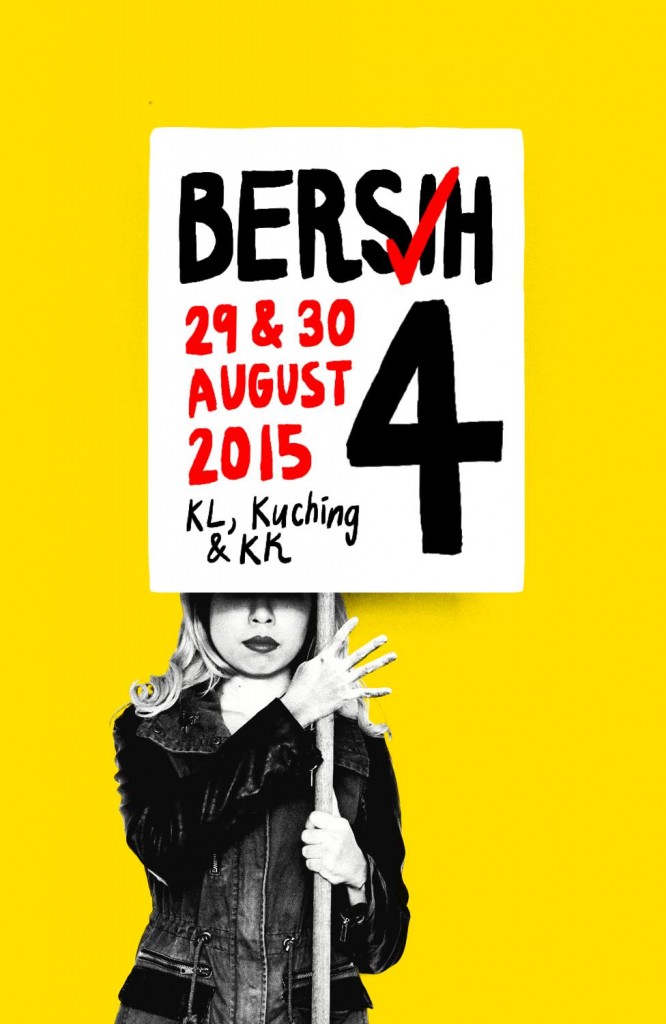In light of the upcoming Bersih 4 protests, happening on 29-30 August 2015, I’m sharing a paper I presented on artistic engagements with previous Bersih protests at an academic conference in March 2015. The paper is a work-in-progress and will be revised accordingly to include recent events. Feedback on the piece is welcomed.

Street protests profoundly shape my scholarship, even though my research is not primarily on this topic. While working toward my Ph.D in New York City, the first Bersih protests in 2007 happened. Like many Malaysians abroad, I followed the news online, stunned by the number of people that descended on the streets and outraged by the police violence that greeted the protestors. When I first started working on my dissertation in 2010, Occupy Wall Street burst onto the scene, electrifying my academic community and intellectual environment. Watching these two protests unfold at more or less the same time, even as mass demonstrations were erupting all over the world, I had a hunch that the events in New York and Kuala Lumpur shared common ground in subtle, complex ways despite their different aims.
Directed at Wall Street, the Occupy movement questioned the very efficacy of electoral democracy in representing public interests given the ways in which profit-driven transnational corporations had co-opted the state, as evident in the fall-out from the 2008 global financial crisis. (It should not be forgotten that American electoral democracy has never offered equal representation to every one and was never intended to from its very onset).
Meanwhile, in Kuala Lumpur, the Bersih rallies, which called for procedural reform to ensure clean and fair elections, expressed a deep belief in the structures of electoral democracy (“bersih” means clean in Malay). Save for “anti-corruption” slogans, political-economic critique is largely absent in Bersih and the rhetoric of its organizers reflects an unquestioned acceptance of capitalist developmentalism (cf. Bersih4 organizers’ stated aim of “saving the economy”).
However, the circumstances that instigate these mass demonstrations are largely facilitated by the structures of globalized financial capital. For instance, Bersih traces its genealogy to the 1997 Reformasi protests triggered by the arrest of then Deputy Prime Minister, Anwar Ibrahim, which was prompted by the impact of the Asian financial crisis on the national economy. The Bersih 4 protests are agitating for accountability against an endemically corrupt authoritarian-capitalist government following evidence incriminating Prime Minister Najib Razak’s pocketing of public funds via 1MDB, a government owned investment corporation (See here, here, and here). The obvious needs stating: international financial institutions—specifically, in New York, London, Singapore, and Switzerland—have facilitated the flow of public money into the few pockets of the powerful.
Trying to make sense of the contemporaneity and incongruity of these events animated my thinking as I wrote my dissertation—which opens with a reading of a protest sign in the Kuala Lumpur Bersih 3 rally of 2013—on translation, globality, and the formation of postcolonial Malaysia.
This paper is a more direct attempt at understanding the Bersih protests in light of the worldwide eruption of mass demonstrations in recent years through the analysis of art. While ethnographic and sociological analyses of the Bersih movements are important, I am deeply convinced that interpreting the protests as modes of aesthetic production is as valuable and necessary. I say this not only because I am a humanities-trained scholar and this is what I know how to do. That anti-Bersih groups have taken to doing performance art on the streets to protest the protests is but one example that attests to the street as theatre space. Politics is art and engaging with its aesthetic dimension, I believe, enables us to imagine the political differently.
The shift in focus away from regime change, which preoccupied previous Bersih protests, has led to a proliferation of voices, expressions, and art. It is a veritable Babel. I am listening for the musicality of the cacophony.
Paper Title:
Terms of Participation: Notes on Contemporaneity and Artistic Engagements with Malaysia’s Bersih Protests
Paper abstract:
From 2007 to 2012, Bersih, a coalition of non-governmental organisations calling for reform in the Malaysian electoral system, held three rallies that gathered hundreds of thousands in Kuala Lumpur. These protests are largely deemed a people’s movement and a sign of transition from an authoritarian to a more democratic social political order. This paper examines the significance of the Bersih protests by considering how artists engaged with these events and the artworks they created in response. I focus on three figures, A. Samad Said, the National Literary Laureate and official spokesperson of Bersih, the artist Sharon Chin, and activist Fahmi Reza. The latter two respectively devised performance and visual pieces for the rallies that were subsequently featured in art institutions, the former at the 2013 Singapore Biennial and the latter in the Klang Valley. In their own ways, these artists invited fellow protestors to reflect on their relationship with one another as they participated in collective action, and on their relationship with authority figures. Their artistic interventions complicate the idea that Bersih reflects the rise of people’s power by implicitly questioning the hierarchical models that governed the protest’s terms of participation. Moreover, given that their artworks were situated both in the street and in cultural institutions, these artists incite conceptual questions on the relation between art and politics in analyses of political movements and contemporary art. Going beyond notions of art as political propaganda, or as reflecting the political ideologies of the times, these artists ask, how might the process of constituting collectivity be thought not just in political, but in aesthetic terms as well?
Access paper here.
Comments by Fiona Lee